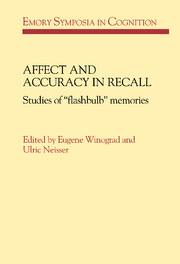Book contents
- Frontmatter
- Contents
- Preface
- List of contributors
- 1 Introduction
- Part I Empirical studies
- Part II Developmental studies
- Part III Emotion and memory
- 7 A proposed neurobiological basis for regulating memory storage for significant events
- 8 Remembering the details of emotional events
- 9 Do flashbulb memories differ from other types of emotional memories?
- 10 Why do traumatic experiences sometimes produce good memory (flashbulbs) and sometimes no memory (repression)?
- Part IV Theoretical issues
- Author index
- Subject index
7 - A proposed neurobiological basis for regulating memory storage for significant events
Published online by Cambridge University Press: 22 March 2010
- Frontmatter
- Contents
- Preface
- List of contributors
- 1 Introduction
- Part I Empirical studies
- Part II Developmental studies
- Part III Emotion and memory
- 7 A proposed neurobiological basis for regulating memory storage for significant events
- 8 Remembering the details of emotional events
- 9 Do flashbulb memories differ from other types of emotional memories?
- 10 Why do traumatic experiences sometimes produce good memory (flashbulbs) and sometimes no memory (repression)?
- Part IV Theoretical issues
- Author index
- Subject index
Summary
Introduction
The goal of this chapter is to describe the biological systems that appear to promote the formation of memories for especially important information. The findings discussed here suggest that the most direct extrapolation from the evidence currently available is that “flashbulb” memories are not unique but represent a special case of more general neuroendocrine regulation of the biological processes responsible for storing information. It is also important to note that the same physiological processes appear to regulate not only memory systems but also a wide range of nonmemory neural and behavioral measures. Thus, at a neurobiological level, the findings suggest a more broadly based behavioral conception of what is regulated–including, but going beyond, memory.
The major point is that information comes in and is acted upon in retrograde fashion by neuroendocrine responses to the experience to promote the storage of recent information. The chapters included in this volume consider the viability of the view that there are unusually complete memories for ancillary information surrounding significant events. These firm memories are usually tested for events important to a large segment of a society, but presumably also apply to individually based significant events as well. It is only the latter case – individually specific memories – that is addressed directly by the neurobiological data.
At a biological level, there are two interacting processes that must be considered to gain a full understanding of the biological bases of memory storage. One consists of the neurobiological substrate mechanisms themselves.
- Type
- Chapter
- Information
- Affect and Accuracy in RecallStudies of 'Flashbulb' Memories, pp. 141 - 161Publisher: Cambridge University PressPrint publication year: 1992
- 24
- Cited by



